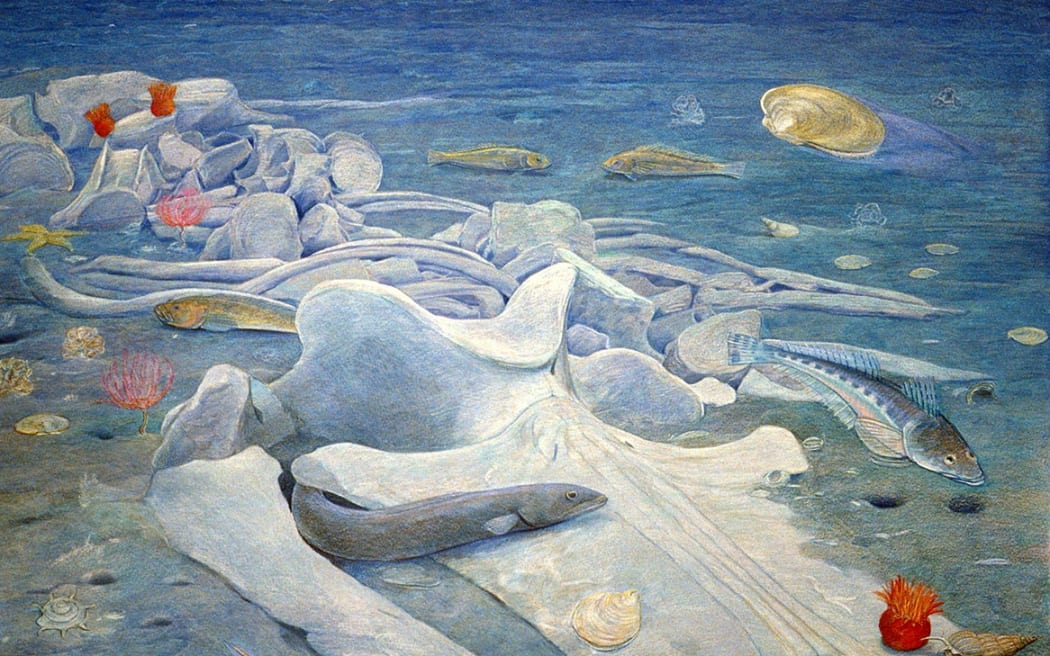From prehistoric beasties to recently-extinct native birds, Aotearoa's soil is laden with fossils. But if problems surrounding fossil hunters and collectors aren't fixed, some of that history could be lost to the sands of time.

Burial in the ancient sea of Zealandia: a Toipahautea whale skeleton is slowly covered by sand 27-28 million years ago, on its path to become a fossil Photo: Reconstruction by Chris Gaskin, ©Geology Museum, University of Otago
When palaeontologist Dr Nic Rawlence pulled a giant ice-age moa skeleton out of a South Island swamp, he knew the marks on its pelvis bone would tell the story of how it died.
They were rip marks from the talons of a Haast's eagle, which became extinct around 1400.
"The moa's got stuck in a swamp, the Haast eagle has come down, landed on the back and just ripped out all the bone, down there where the kidneys would be," says Rawlence.
"It's pretty amazing, you're pulling out these bones that haven't seen the light of day for thousands, tens of thousands of years. You can think of it as just like different pages of the prehistoric book of New Zealand."
But he warns Aotearoa is losing pages of this book faster than the fossils can be found and preserved, as sites are eroded "in front of our eyes".
Part of the problem, he says, is New Zealand's small and ageing community of professional palaeontologists and amateur 'rockhounds', who go fossil hunting to build their own collections, or sell to museums or private collectors.
Rawlence says more young people need to be enticed into the community and shown that palaeontology is more than a dusty science of old, white males with beards, wearing t-shirt, shorts and tramping boots.
He wants more collaboration within New Zealand and internationally on projects such as the campaign to save Foulden Maar, a nationally significant fossil site in Central Otago, from commercial mining.
He's also working on a fossil version of Bird of the Year, where the public will get to vote on their favourite prehistoric creature. The New Zealand Fossil Emblem Campaign is aimed at promoting fossil tourism and raising awareness of the need for fossil protection strategies, he says.
Fossil hunting, who has rights to them and how they are preserved has been in the spotlight after three people hacked into a riverbed on the West Coast and took a 23 million-year-old whale fossil last month.

Dr Nic Rawlence is the director of the Otago Palaeogenetics Laboratory. Photo: Supplied
Rawlence explains to The Detail that the law and ethics surrounding fossils is murky. All archaeological sites (human remains or manmade objects) are protected, but not all fossils are.
For example, fossils on private land belong to the landowner and can be extracted with their permission. On public land they belong to the Crown, and a permit is needed to extract them. On the no man's land of riverbeds or foreshore, it's finders keepers, but Rawlence says most councils have bylaws restricting excavation.
"If you can get to it easily, if you can carry it away with you, if you can do minor excavation with a rock hammer and a rock chisel, then you can take it away," he says.
He adds that fossil hunters should, out of courtesy, contact mana whenua and local authorities.
Rawlence goes on to explain why it's so difficult to export them and what happens when the Ministry of Culture and Heritage gets involved.
He says fossils tell the story of our past, but also provide important information on our future.
"There's a famous phrase in geology that the past is the key to the present and I would argue the future. If we can work out how animals and eco systems responded in the past to similar climactic and human-driven variables we can then predict how they may respond in the future."
Find out how to listen and subscribe to The Detail here.
You can also stay up-to-date by liking us on Facebook or following us on Twitter.

Photo:


